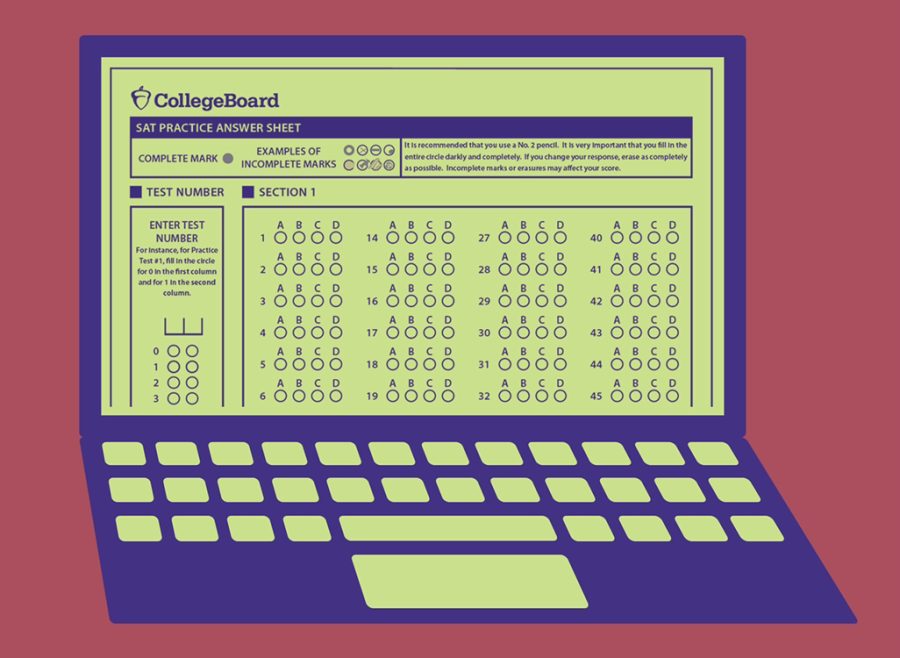SAT going online prompts unanswered questions
The College Board has stated that in 2024 the SAT will be administered on either a computer or a tablet, in comparison to being on paper.
February 16, 2022
No more bubbling in answers and no more No. 2 pencils for the new SAT.
In an attempt to modernize an age-old test, the College Board has announced that the SAT will be subject to its biggest change in history. Starting in 2024, the test will be completely digital, cutting an hour of the test length and making the questions adaptive. While these changes may streamline the SAT, this announcement sparks major questions and concerns that so far, go unanswered.
The biggest change to the test is the online format. Students will be able to bring a personal computer or laptop from home to take the test, and the College Board will provide a computer to students who do not bring one. We can only assume the College Board will require software to be installed as they did with the 2021 Advanced Placement exams to prevent cheating, yet the organization hasn’t specified.
There are an estimated 2,000 students who cheat on the SAT each year. With students used to cheating on regular digital school assignments, this new SAT may offer a way for dishonorable conduct on arguably the most important test a student will ever take. With this new test approaching fast, it would be in their best interest for the College Board to come out with a full report of how the new test will be administered, in order to make sure this new format doesn’t breed deception.
The addition of adaptive testing also shortens the test from three hours to two. Adaptive testing gives students a baseline of questions and gauges their accuracy to cater to the students’ appropriate performance level. With this new type of testing, thoughts circle around fairness and accuracy in these adaptive questions. How could a test be fair when students are getting different questions at different levels? And what if a student accidentally missed an easy question and could answer harder ones, but was never given that opportunity? The College Board hasn’t even begun to address these situations.
Aside from the adaptive questions, the reading and math sections are also getting a complete makeover. Instead of a total of four sections, there will be two, each worth 800 points. The reading and writing section will entail shorter passages with only one question per passage. This positive change will allow students to stay more focused, as they are not having to absorb entire page-long passages.
In another step in the right direction, the passages will also be more catered to what students will learn in college to better prepare them. Instead of two math sections separated into no calculator and calculator sections, the new SAT will only have one all calculator section. For years, the SAT has tested outdated information. The Resilient Educator, a virtual space for teachers and educators, writes that “critics of the ACT and SAT point to their archaic vocabulary in the verbal section or the focus on getting a specific answer in the math section as signs of the tests’ outdated methodology.”
Furthermore, moving the test online will allow for a more streamlined score process and a more secure testing process. There will be no worrying about lost or tampered testing booklets. Scores will be released within days, letting students know weeks faster than compared to the current release timeline. The quicker students receive their scores, the quicker they can alter their testing timeline, and schedule another test if they didn’t get the score they wanted
This digital format is also a big change for educators who have to administer the test. In years past, educators would have to guide students in filling out the tedious bubble sheets and scantrons, then guide students through four entire sections. The old test was very tedious for educators to administer. Now, all administrators will have to do is help students through the login process and two sections.
In November 2021, the College Board did a pilot run of the digital SAT, and found that “80 percent of students responded that they found it to be less stressful and 100 percent of educators reported having a positive experience.” Though these changes to the SAT may be overwhelmingly positively received, the College Board still needs to address questions regarding how the test will work. The SAT is a critical part of the stressful college admissions process, and by creating so much uncertainty surrounding the new format, the College Board is only adding fuel to the fire.








